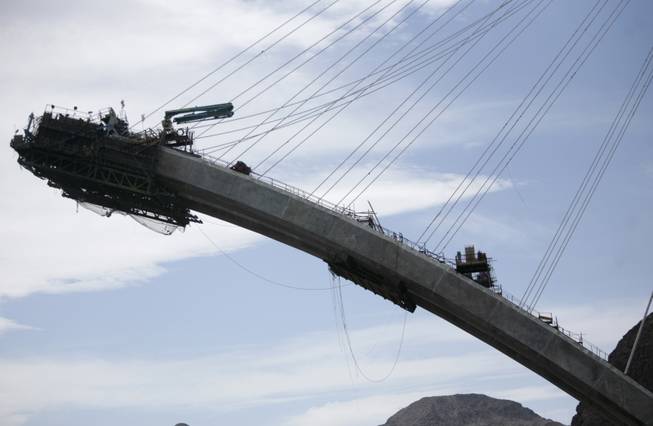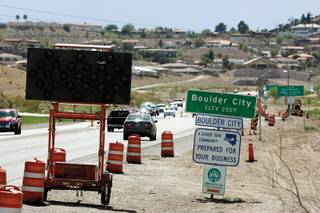
The Hoover Dam bypass bridge over the Colorado River has been under construction since 2005 and is scheduled to be finished in June of 2010.
Tuesday, April 28, 2009 | 1:59 a.m.
Hoover Dam bypass bridge
Assemblyman Joe Hardy hasn’t given up on legislation that might allow the Boulder City Bypass to move forward as a toll road, even though the two pieces of legislation that would have made tolling legal failed to pass the Assembly.
The proposed Boulder City Bypass would redirect traffic south of Boulder City, but little money is available for the $300 million project. Building it as a toll road has been seen as a way to get it built before 2025, which is the soonest NDOT says it will be built with state money.
Tolling is currently illegal in Nevada.
“It’s becoming more evident that a bypass around Boulder City as far as tolling is concerned doesn’t look good, but that doesn’t mean it couldn’t happen,” Hardy said.
Hardy’s Assembly Bill 464, which would have allowed tolling specifically for the Boulder City Bypass, and Assembly Bill 524, which the Nevada Department of Transportation was pushing to allow tolling for express lanes on U.S. 95 and Interstate 15, both failed to get out of the Assembly Transportation Committee.
Still in the mix, Hardy points out, is Senate Bill 206, which sets guidelines for tolling. The bill has moved into the Assembly and been sent to the Assembly Transportation Committee, but it has not yet been scheduled for a hearing.
The Boulder City Bypass is proposed as a way to deal with increased traffic, especially from heavy trucks, once the Hoover Dam bypass bridge is completed late next year. Once the bridge bypass opens, 18-wheelers and other trucks that were banned from crossing Hoover Dam after Sept. 11 will be allowed to use U.S. 93 again — a shorter route than U.S. 95 through Laughlin, which they have been using since 2001.
The sponsor of S.B. 206, state Sen. John Lee (D-Clark), has called it an anti-tolling bill. But Hardy said it could come through the legislative session with an amendment to allow tolling for the Boulder City Bypass.
The Assembly Transportation Committee is the same committee that stopped the previous two bills that would have established tolling projects, but Hardy doesn’t sit on the committee, so he doesn't have a direct voice on how the Senate bill will fare in front of it.
However, Hardy said he believes the Boulder City Bypass by itself could overcome some of the objections the Assembly Transportation Committee has previously listed against tolling: The Boulder City Bypass would be a new road that would have a free alternative, and it could be built in such a way that traffic does not have to stop to pay.
“At that point, it’s hard to find something to object to, but some people still object to the concept,” Hardy said.
There could be plenty of other objections to the Boulder City Bypass, however, beginning with a benefit-cost analysis done by NDOT that shows the Boulder City Bypass doesn’t make financial sense. A new analysis is being conducted, NDOT spokesman Scott Magruder said, but the most recent one, done in 2007, shows of seven state highway projects analyzed, the Boulder City Bypass was the only one that had a negative benefit for the cost.
Magruder said the analysis is being redone because NDOT believes there has to be some benefit from building the road, “even if it’s a minor one.”
Hardy says the analysis didn’t take into account lives that could be lost because of increased truck traffic when the Hoover Dam bypass bridge opens in 2010, but trucking industry spokesman Paul Enos says the numbers speak for themselves.
“From the information I have today and from the benefit-cost analysis I’ve seen, the state would be wasting money to build that bypass,” Enos, who represents the Nevada Motor Transport Association, said.
If tolling were to become an option, Enos said, it would be difficult to attract the capital because of the lack of return, and it might be difficult to persuade trucks to use it instead of the free U.S. 93 truck route.
It would also add an extra 15 miles to the trip, Enos said, adding that he fears that tolls for trucks would be made significantly higher than for cars to help pay the cost.
It would ultimately be a question of a benefit-cost analysis for each trucker, Enos said.
“Trucks don’t like congestion either,” he said. “When they’re idling, they’re wasting fuel. That’s an unproductive use of fuel and time. However, all of those things may be balanced out by the other costs.”
Hardy and other Boulder City officials have argued that all the new bridge will do is move the choke point along U.S. 93 from Hoover Dam to Boulder City, but Dave Zanetell, project manager for the bridge, says his project’s completion will improve the traffic flow for everyone.
The main reasons for the gridlock on Hoover Dam are tied to the high rate of accidents and the frequency of pedestrians stopping traffic, Zanetell said. The crash rate on the approximately 3.5-mile portion of U.S. 93 that will be replaced by the bypass bridge project is three times higher than on U.S. 93 in Boulder City or on the Arizona side, he said.
He added that the bridge bypass is on schedule for completion late next year and still on its original budget, which is “good news for the public.”
It’s good news, unless that public happens to be the residents of Boulder City, who dread the opening of U.S. 93 to heavy trucks again.
That is why Hardy continues to fight for the Boulder City Bypass and the ability to build it as a toll road, he says.
“When the bridge done, the good citizens of Boulder City won’t be happy people, and rightfully so,” Hardy said. “It will be a risky venture to drive across, through, and on Nevada Highway.”
The ability to build the Boulder City bypass as a toll road at least keeps the project alive. If a private partner could be found, the project could bring new revenue to the state, Hardy said.
“Right now it’s illegal to do tolling and video monitoring,” he said. “It’s hard to go to a company and ask if they would like to give us an estimate. It’s problematic to get people to study it.”


Join the Discussion:
Check this out for a full explanation of our conversion to the LiveFyre commenting system and instructions on how to sign up for an account.
Full comments policy